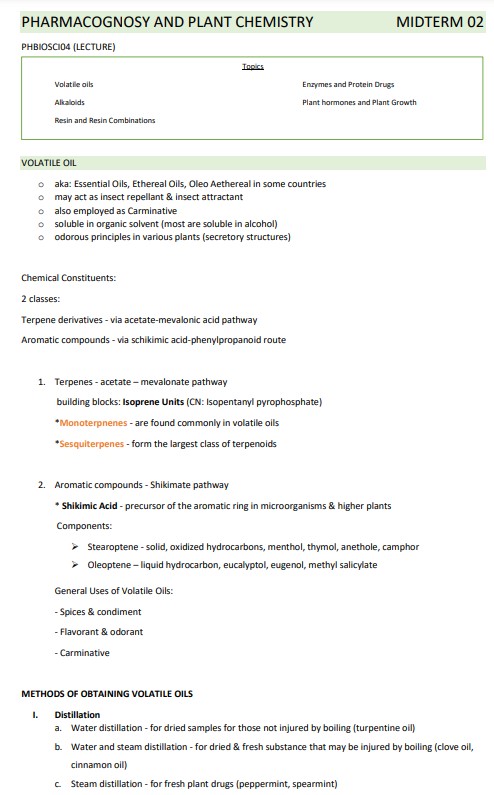Pharmacognosy and Plant Chemistry (Grade A+)
Summary:
The pharmacy notes for the subject of Pharmacognosy and Plant Chemistry cover several important topics. These include volatile oils, alkaloids, resin and resin combinations, enzymes and protein drugs, plant hormones and plant growth.
Volatile oils are substances derived from plants with a strong odour and evaporate quickly. They are commonly used to produce perfumes, cosmetics, and flavourings. Alkaloids, on the other hand, are nitrogenous organic compounds found in plants, often possessing pharmacological effects. They are frequently utilized in the development of drugs due to their medicinal properties.
Resins and resin combinations are natural plant products with a sticky or viscous consistency. They are used in various industries, including pharmaceuticals, as binders or coatings. Enzymes and protein drugs derived from plants have diverse applications, ranging from therapeutic purposes to industrial processes.
Plant hormones play a crucial role in regulating plant growth and development. Studying these hormones can provide insights into their potential use in agriculture and horticulture practices.
Overall, these pharmacy notes provide a comprehensive understanding of pharmacognosy and plant chemistry, shedding light on the properties and applications of volatile oils, alkaloids, resins, enzymes, protein drugs, plant hormones, and plant growth.
Excerpt:
PHARMACOGNOSY AND PLANT CHEMISTRY
PHBIOSCI04 (LECTURE)
Topics
Volatile oils
Alkaloids
Resin and Resin Combinations
Enzymes and Protein Drugs
Plant hormones and Plant Growth
VOLATILE OIL
o aka Essential Oils, Ethereal Oils, Oleo Aethereal in some countries
o may act as insect repellant & insect attractant
o also employed as a Carminative
o soluble in organic solvent (most are soluble in alcohol)
o odorous principles in various plants (secretory structures)
Chemical Constituents:
2 classes:
Terpene derivatives – via an acetate-mevalonic acid pathway
Aromatic compounds – via shikimic acid-phenylpropanoid route
1. Terpenes – acetate – mevalonate pathway
building blocks: Isoprene Units (CN: Isopentanyl pyrophosphate)
*Monoterpenes – are commonly found in volatile oils
*Sesquiterpenes – form the largest class of terpenoids
2. Aromatic compounds – Shikimate pathway
* Shikimic Acid – the precursor of the aromatic ring in microorganisms & higher plants Components:
➢ Stearoptene – solid, oxidized hydrocarbons, menthol, thymol, anethole, camphor
➢ Oleoptene – liquid hydrocarbon, eucalyptol, eugenol, methyl salicylate
General Uses of Volatile Oils:
– Spices & condiments
– Flavorant & odorant
– Carminative


Reviews